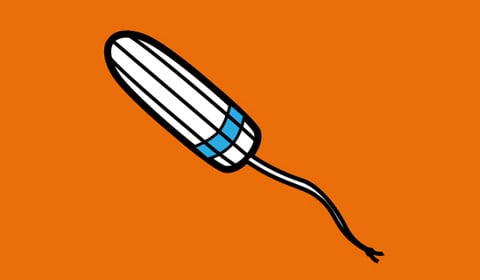What it is
TSS is a rare but serious illness that may cause death. It is caused by a toxin (a kind of biological poison) which is produced by a type of bacteria (Staphylococcus aureus).
These bacteria are found in the nose of about one-third of the population. They may also be found on the skin, and occasionally in the vagina, without causing harm.
Who is at risk
TSS can occur in both females and males of any age. It is more common in young women who use tampons during their period.
The symptoms
Symptoms can appear very quickly and are similar to the flu. They include:
- Feeling very ill, headache, muscular pains
- A sudden high fever and chills (39°C or higher)
- Vomiting or diarrhoea, or both
- Dizziness, fainting, weakness or confusion
- A rash that looks like you’ve got a nasty sunburn
Be on the lookout for the above symptoms, but remember that not all TSS cases are exactly alike, and not all of these symptoms are always present. If you have any of these symptoms during or soon after your period, remove your tampon and see a doctor immediately.
When you meet with your doctor, it’s very important to let him or her know that you’ve been using tampons. If you have ever had TSS, you should not use tampons until you have discussed it with your doctor. You may not have developed resistance to the toxin and could get TSS again.
How does TSS occur
If the toxin is produced in the vagina or a wound, and absorbed from there into the bloodstream, a person who is not resistant to the toxin may become ill. Most people develop resistance to the toxin (that is why the illness is so rare) and in these people there is no harmful effect.
The symptoms of TSS may develop rapidly. Early recognition and treatment of these symptoms can usually prevent serious illness.
Do tampons cause TSS
The simple answer is no. Tampons do not carry the bacteria which cause TSS. However, tampon use has been has been associated with an increased risk of TSS. Although TSS can occur with the use of tampons of any absorbency, the risk increases with the use of tampons of higher absorbency.
Please note that tampons are not sterile, neither are your hands or vagina. Tampons, while containing very small amounts of bacteria normally present in the air, have not been shown to carry the bacteria that cause toxic shock syndrome (TSS).
Precautions for tampon use
- You may reduce your risk of TSS by using the lowest absorbency tampon necessary to suit your flow. Although TSS can occur with tampons of any absorbency, the risk of TSS increases with tampons of higher absorbency
- Only use one tampon at a time
- Wash your hands before unwrapping and inserting a tampon and again afterwards
- Use the tampon immediately after you unwrap it and don’t handle the tampon more than necessary, or place it on any surface
- Don’t force the tampon to fit inside the vagina
- Change your tampon regularly (every 4 hours is a good guide, unless your flow is heavy) and never leave one in for more than 8 hours
- Remove the used tampon before inserting the next one
- Don’t forget to remove the last tampon used at the end of your period
- Only use tampons when you are menstruating
- Ask your doctor if it is okay to use tampons if you have recently given birth, had a caesarean section, a miscarriage, an abortion or any operation on your reproductive system.
For more information visit www.toxicshock.org.au.
The advice provided in this material is general in nature and is not intended as medical advice. If you need medical advice, please consult your health care professional.







